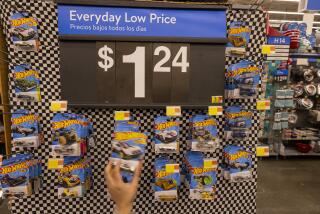Scanner Errors Usually Favor Buyers
- Share via
WASHINGTON — Price scanners widely used in supermarkets and other stores are fast but sometimes wrong, and the errors on average benefit consumers, according to a study released Tuesday.
The Federal Trade Commission study found that grocery stores, which have used scanners the longest of any retail category, are the most accurate, with an error rate of 3.47% and an average overcharge of 53 cents and an average undercharge of 72 cents.
Department stores were found to be the least accurate, with an error rate of 9.15% for undercharges and 3.25% for overcharges. The average department store overcharge was $7.52 and the average undercharge was $5.29, but there were more undercharges than overcharges.
FTC inspectors made 17,000 random purchases at 294 food, discount, home, drug and department stores in seven states over an 18-month period. They found that they were overcharged 2.24% of the time and undercharged 2.58% of the time.
“Overall, most stores didn’t do badly,” said FTC spokeswoman Bonnie Jansen. “To the extent that there are errors, they are more result of carelessness and inattentiveness rather than willfulness.”
In total, there were errors in 4.82% of the purchases. The FTC is not releasing figures for individual stores.
That undercharges outnumber overcharges was good news to John Motley, senior vice president for the National Retail Federation, which represents department stores and, to a lesser extent, grocery and drug stores.
“From our standpoint, we would much prefer to make mistakes on behalf of the consumer. That eliminates anybody’s inclination to say this is on purpose and we’re being unfair,” Motley said.
Still, stores lose money on every undercharge and are looking for ways to make the system more accurate.” It is an ongoing problem within the industry,” he said.
Scanners have been an industry concern for many years, Motley said, pointing to past accusations of foul play.
“There was concern raised by the government that this was a not-too-subtle attempt at consumer fraud,” Motley said.
Jansen noted that several states have statutes regulating scanners, ranging from a requirement that stores include prices on individual items to a guarantee that a customer who finds an error will get the item for free. Several retailers have paid large fines after their scanners were found to be inaccurate, the FTC added.
Scanners allow a computer to read a black-and-white bar code that indicates the item’s price. They largely eliminate the days when customers stood in line while a cashier yelled “price check!” and waited for the answer.
The scanners also help stores keep track of inventory and conduct market research, and they save time and money by eliminating price tags on individual items.
Consumers benefit from faster checkout times and detailed cash register receipts, the FTC said.
Most mistakes come when the price on the shelf is not changed to match the price in the computer or prices in the computer are not updated, the agency said.
Grocery stores, which pioneered scanners more than two decades ago, did the best, with errors just 3.47% of the time.
The study suggested that stores run periodic price checks, and when errors were found correct them and compensate consumers.
“We encourage consumers to do a little pushing as well whenever they find pricing errors,” said Jodie Bernstein, director of the FTC’s Bureau of Consumer Protection.
* Food stores overcharged researchers on 1.92% of items and undercharged them on 1.55%.
* Discount stores: 1.87% overcharged, 2.68% undercharged.
* Home stores: 2.52% overcharged, 2.84% undercharged.
* Drug stores: 3.56% overcharged, 2.75% undercharged.
More to Read
Inside the business of entertainment
The Wide Shot brings you news, analysis and insights on everything from streaming wars to production — and what it all means for the future.
You may occasionally receive promotional content from the Los Angeles Times.









